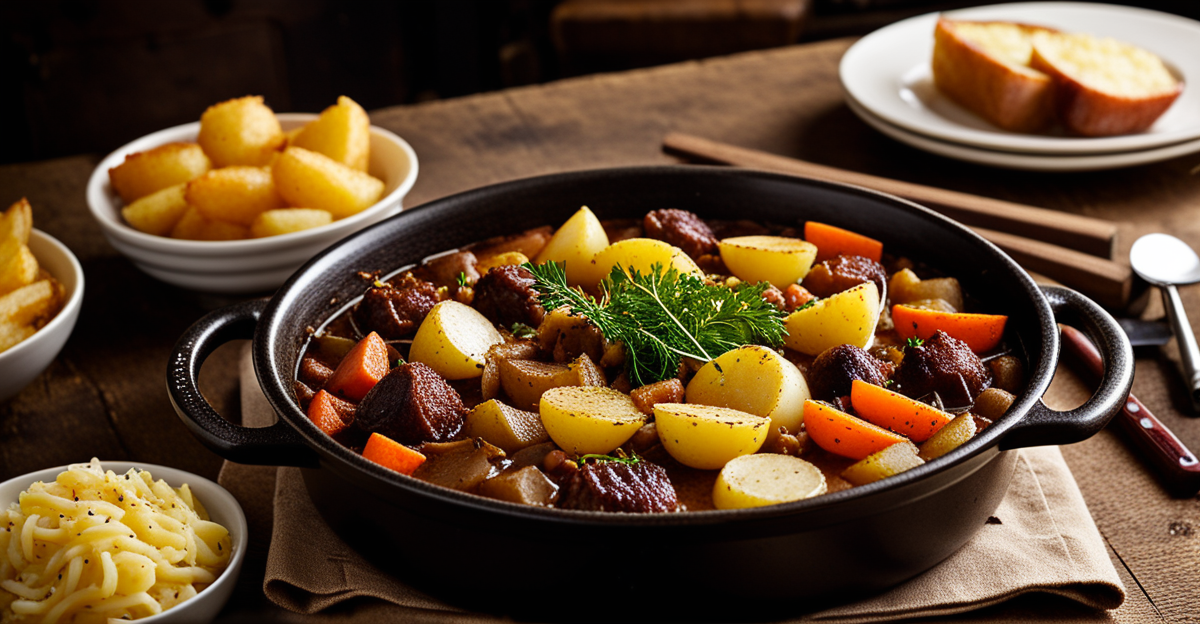Essential Ingredients of a Traditional Lancashire Hotpot
The Lancashire hotpot ingredients form the foundation of this beloved British classic. At its core, the authentic hotpot consists of tender lamb or mutton, sliced potatoes, and sweet onions. Each ingredient contributes distinct qualities: the meat provides rich, hearty flavor and protein; potatoes serve as a soft, starchy cushion that absorbs the savory juices; and onions add a natural sweetness that balances the dish’s robust taste.
Common additions often include carrots, which introduce subtle earthiness and color, along with stock or gravy. The stock is crucial in melding all elements, creating a moist, succulent texture that defines traditional British dishes like the hotpot.
Understanding these ingredients sheds light on why the Lancashire hotpot remains a staple in British culinary tradition. The combination is simple yet effective, focusing on locally available produce and economical cooking. This simplicity preserves authenticity and ensures that every mouthful is infused with comforting, layered flavors that elevate the humble ingredients to something truly special.
Preparation and Cooking Method
The Lancashire hotpot preparation relies heavily on the classic hotpot layering technique, which involves arranging sliced onions and lamb evenly at the base of the dish before topping it with a layer of thinly sliced potatoes. This structure is essential to achieve the characteristic melding of flavors and textures found in traditional British dishes like the authentic hotpot.
Slow-cooking plays a vital role in developing the depth of flavor that defines the Lancashire hotpot. Cooking the dish at a low temperature for an extended period allows the lamb to tenderize fully while the potatoes absorb rich meat juices and stock. This gentle simmering method ensures the flavors marry well and the texture remains moist yet hearty, which is central to many slow-cooked British recipes.
Typically, this dish is prepared in a heavy, ovenproof pot or casserole, often made of cast iron or ceramic, ideal for even heat distribution. The hotpot is usually served directly from this cookware, emphasizing its rustic, home-cooked appeal. This method not only retains heat but also enhances the experience, inviting diners to enjoy the comforting essence of a well-crafted Lancashire hotpot.
Preparation and Cooking Method
Mastering the art of slow-cooked comfort
Lancashire hotpot preparation hinges on a classic hotpot layering technique that maximises flavour and texture. The traditional British dishes method starts with a base of tender lamb or mutton placed in an ovenproof dish. Over this, a layer of thickly sliced onions is spread, followed by alternating layers of sliced potatoes and occasionally carrots. This careful stacking ensures each ingredient’s juices mingle, creating a rich, succulent result.
Slow-cooking is essential for depth of flavour in an authentic hotpot. Typically cooked at moderate oven temperatures for two to three hours, this method softens the meat while allowing the potatoes to develop a golden, crisp topping. Slow heat also lets the stock or gravy infuse the layers, enhancing taste and moisture.
The preferred cookware is a heavy, lidded casserole or earthenware pot that retains heat evenly. Serving traditionally involves ladling portions straight from the dish, showcasing the inviting golden crust and tender layers beneath. This preparation style reflects the essence of many slow-cooked British recipes—simple, hearty, and deeply satisfying.
Optional Ingredients and Regional Variations
Small text
While the Lancashire hotpot ingredients traditionally focus on lamb or mutton, potatoes, and onions, many Lancashire hotpot variations incorporate additional elements to suit local tastes and ingredient availability. For instance, some recipes include kidneys, which add a distinctive, rich flavour and tender texture. Others introduce different vegetables, such as swede or parsnips, enhancing the dish’s depth and nutritional value without straying far from the authentic hotpot style.
Herbs like thyme or bay leaves are common hotpot optional ingredients, imparting subtle aroma and complexity that elevate the simple core. These additions reflect regional preferences and seasonal changes, making each hotpot unique while maintaining its status as a traditional British dish.
Differences across Lancashire and neighbouring regions often stem from historic ingredient access due to trade or agriculture. In some areas, the preference for mutton over lamb prevails, while others may favour a thicker gravy or the use of beer in place of traditional stock. Such regional influences demonstrate the adaptability of the Lancashire hotpot and its lasting appeal, as cooks personalise this heritage recipe to celebrate local flavours and family traditions.
